I have spent £1,000 to be buried with my husband in a Bronze Age burial mound when I die. This is why it is the perfect resting place
It’s been around ten years since Hampshire healthcare professional Caroline Knight heard about an unusual new project.
Tim Daw, a farmer from Wiltshire, was transforming his land into a Bronze Age-style burial mound: a circular stone structure covered with a huge mound of earth.
Inspired by the original ‘burial mounds’ or ‘tumuli’ dating back 5,000 years, the structure at All Cannings near Devizes is said to contain urns containing the ashes of people.
The idea immediately resonated with Mrs Knight, now 73, who was born and largely raised on nearby Salisbury Plain when her father was in the Royal Artillery.
‘Tumuli are just a natural part of the landscape there and were very familiar to us,’ she told MailOnline.
Caroline Knight and her husband Tony (pictured) decided to pay to have their ashes buried in a Bronze Age-style burial mound in Wiltshire
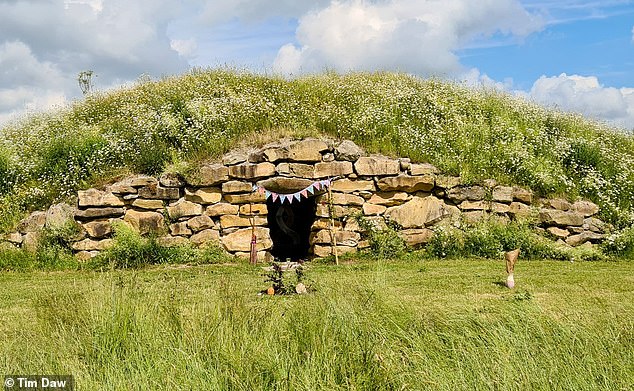
The first modern burial mound – All Cannings, near Devizes in Wiltshire (pictured) – opened about ten years ago and several more have been built since
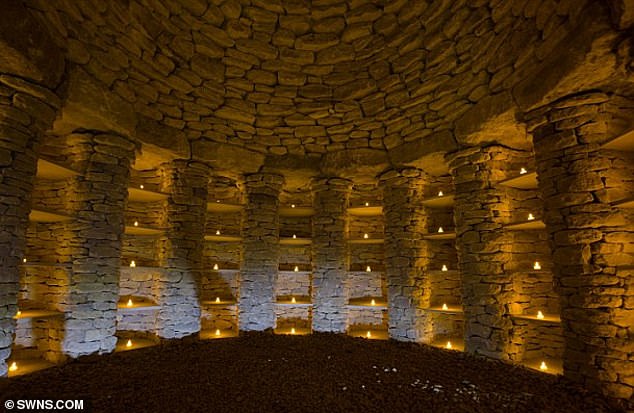
The practice of building the great tomb to store the remains of the dead dates back more than 5,000 years. Pictured: The interior of All Cannings burial mound showing ‘niches’ in the walls, each designed to hold urns containing people’s ashes
“As my husband and I grew older, we had to make a decision about what our children should do with our ashes.
‘When we saw an article about the columbarium on Tim’s land, it seemed like a perfect solution to us.’
Mrs Knight (formerly a radiographer and now retired) and her husband Tony (a forensic medical examiner) booked their place at All Cannings before it was completed.
It means that after they die and their bodies are cremated, their ashes are stored in urns that are placed side by side in a ‘niche’ or ‘alcove’ – a small recess in the wall.
Friends and family can visit on certain days to pay their respects, just like visitors to a grave.
In addition, their niche provides space for two more urns, which also house the ashes of Mrs. Knight’s sister and her husband.
“When we talked to my sister and her husband about it, they agreed it was a suitable place for all of us, so we booked a family place,” Mrs Knight said.
In total, the four family members paid around £1,000 for a 99-year lease for their space in All Cannings.
“If the wheelbarrow becomes full and our niche is needed after that time, the ashes are scattered on the land around the wheelbarrow,” she added.
After visiting the wheelbarrow during the opening ceremony in September 2014, she described it as ‘beautifully built’.
‘It fits well into the landscape and there is a wonderfully peaceful feeling inside.
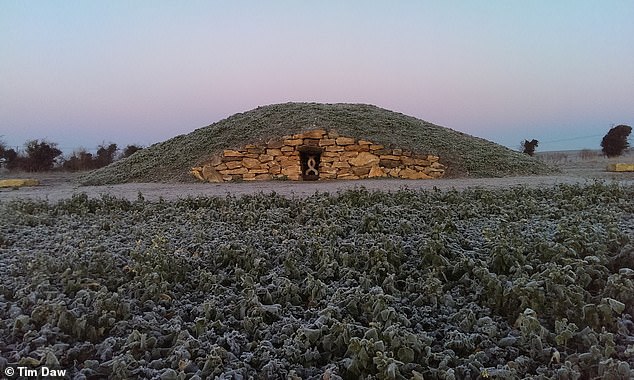
The barrow at All Cannings is described on the website as ‘a spiritual place where people of any faith can come to remember and give thanks, especially for the lives of their loved ones’
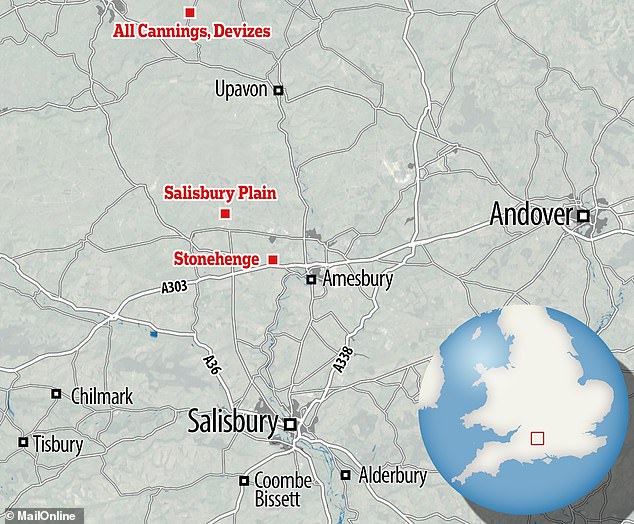
The modern burial mound at All Cannings is located just north of the Salisbury Plain and the world famous Stonehenge
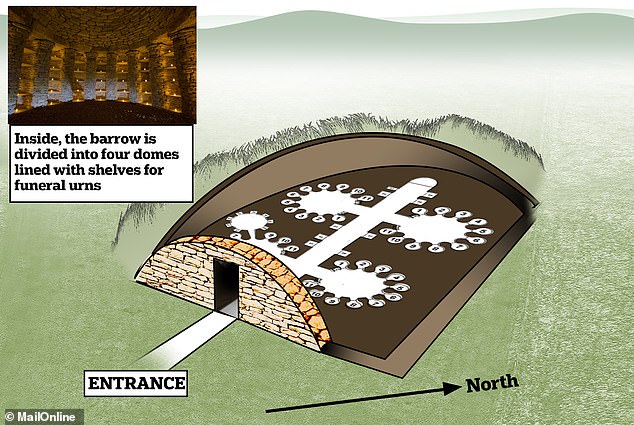
Cross section of all Cannings: from the outside, burial mounds look like small mounds covered with grass, but inside there are rows and rows of niches in stone walls, containing urns containing cremated remains
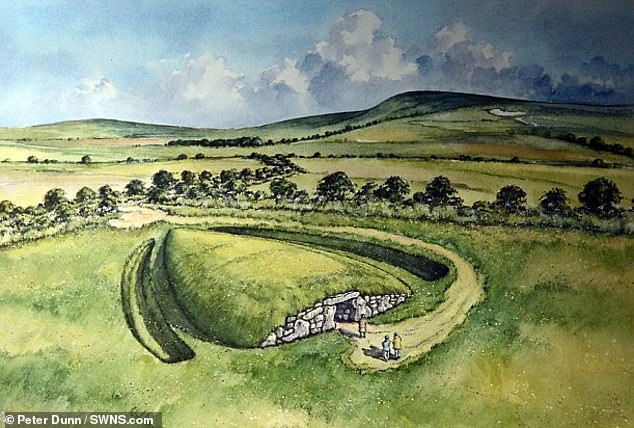
The original barrows (pictured) were built by hand thousands of years ago using natural limestone, lime mortar and traditional techniques
“Our families are happy that no more decisions will have to be made when we are gone.
‘It is paid in full, so no running costs.’
Since All Cannings opened, further barrow locations have sprung up in Cambridgeshire, Dorset, Shropshire and Oxfordshire.
Another is planned on farmland near Milton Keynes in Weston Underwood, Buckinghamshire.
Meanwhile, funeral home AW Lymn has recently been given the green light to build a new burial mound outside Calverton in Nottinghamshire.
According to Pete Clarson, commercial director at AW Lymn, burial mounds are ‘more than a place to bury ashes’.
‘The burial mounds provide an alternative to a burial, yet provide a place where the bereaved can go to understand their grief, accept their loss and celebrate a life,’ he told MailOnline.
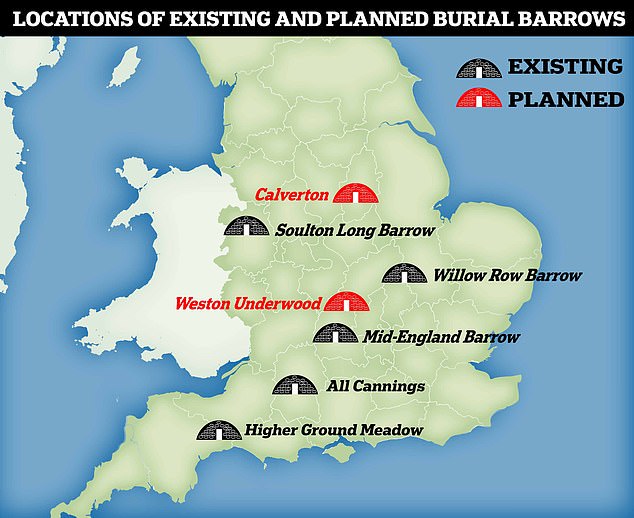
The first modern barrow – All Cannings, near Marlborough in Wiltshire – opened in 2015. Since then, further barrow sites have sprung up in Cambridgeshire, Dorset, Shropshire and Oxfordshire.
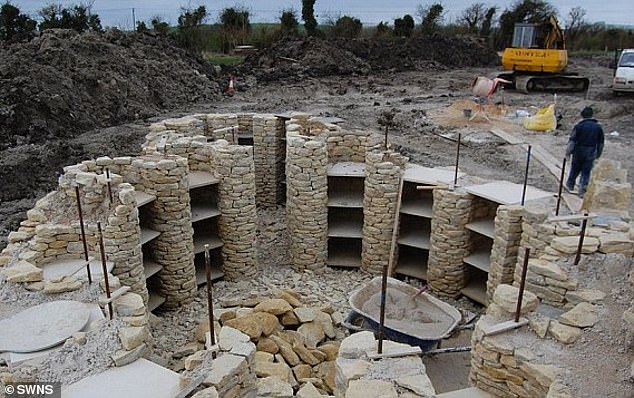
The construction of All Cannings in 2014. When full it will contain approximately 600 cremated remains
‘Situated in a beautiful and tranquil setting, they form a special space made of natural materials where people can go and spend time in memory of their loved one.’
The original burial mounds (tumuli) date from the Early Neolithic to the Middle Bronze Age, around 4000 BC to 1400 BC.
These impressive earthen mounds were built over stone structures that functioned as collective graves, although traditionally built for the social elite.
Sutton Hoo in Suffolk still has around twenty of these barrows, which were reserved for people who owned objects that suggested they had wealth or prestige.
